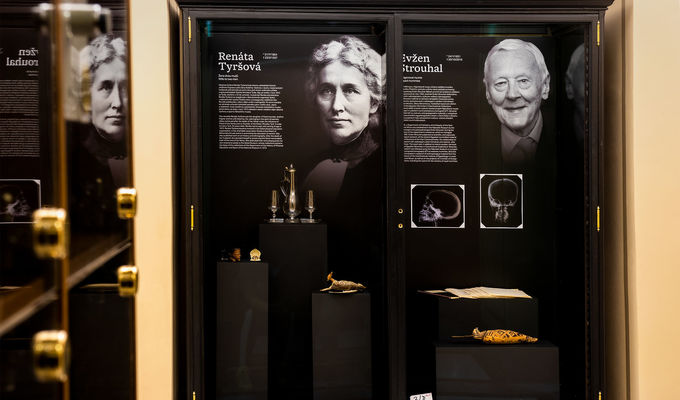Every important building has its foundations, not only structural, but also symbolic. The pillar of the National Museum are its collections. They are the most important thing inside the building, which in itself is one of the most precious items. However, it is the people, not only the founders, employees, donors, but also the visitors, who make the museum come alive. Collections, buildings and people – this is the National Museum. Together they form added values.
The Museum from the cellar to the attic exhibition offers its visitors to peek into the life of the institution. It is symbolically installed in period cabinets designed more than a hundred years ago by Josef Schulz, the architect of the Historical Building. Individual collections and themes across the institution compose a puzzle-like image of the museum in the cabinets. It reflects contemporary scientific practices and knowledge, cultural norms and political changes, as well as modifications in the ways of acquiring, preserving and presenting collections over a period of more than 200 years.
You can look at the museum from four perspectives – in the basement you will get acquainted with the foundations of the institution associated with personalities, on the 1st floor with its buildings, on the 2nd floor with collections and at the dome with current projects.
However, lesser-known themes, personalities and collections are also featured. The space is devoted not only to the founding personalities, but also to the donors, museologists, and even the visitors themselves – what social background the visitors came from or how their views on the exhibitions changed. And, as the architect of the building and the cabinets, Josef Schulz (1840–1917) cannot be missing. His personality was crucial for the institution. This versatile architect designed the Historical Building as well as all the equipment. Next to the cabinets in which you will find the exhibitions, you can still sit down and relax on the benches Schulz designed.
But the National Museum is not just the Museum Complex at the top of Wenceslas Square. The exhibition does not show the present of the buildings, but their past. There used to be a gendarme station where the Czech Museum of Music is located today, a winery where the Náprstek Museum is, a wintering site for circuses where the Natural History Museum is...
The Museum from the cellar to the attic exhibition does not forget about children's visitors either – there is a storyline for children and a fun interactive search game for families with children. The storyline for children accompanies younger visitors throughout the exhibition in the form of dialogues taking place directly on the surface of selected cabinets of the exhibition. The main role in these stories is played by two couples – the architect Josef Schulz and a lost young student, as well as Emil the pigeon and Elvíra the museum mouse, whose main habitat is the children's zone Mouseum in the neighbouring New Building. In the dialogues, the characters present interesting facts about the exhibits on display or surprising details from the fates of famous personalities associated with the National Museum.

